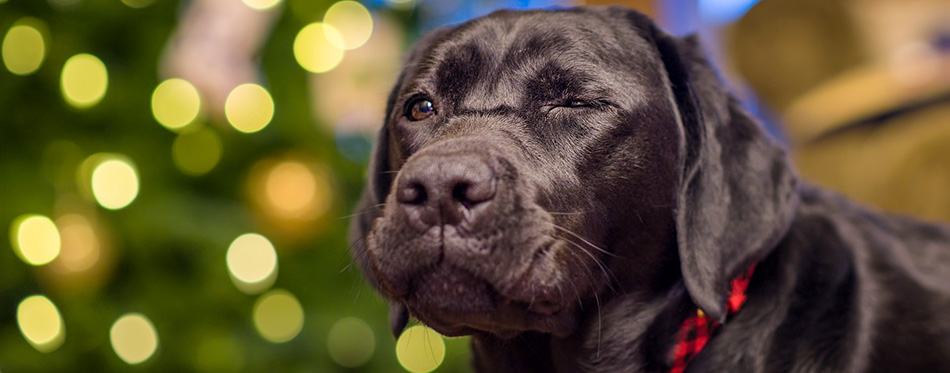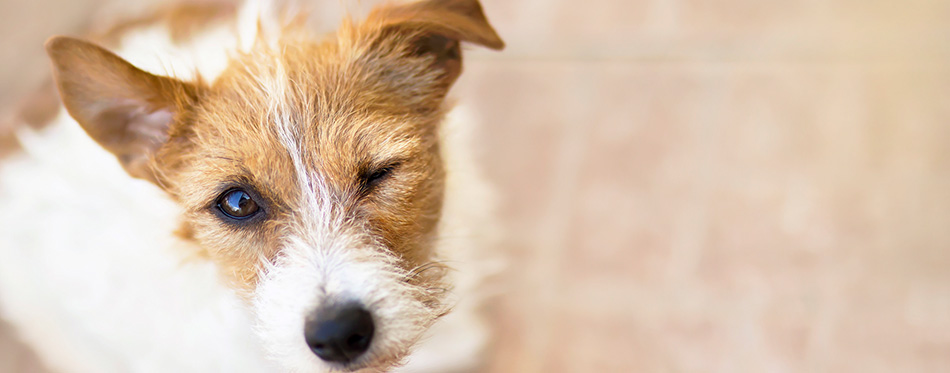If you’ve ever seen your dog winking at you, you’re not alone. Most owners will notice this adorable quirk at some point, which can be as puzzling as it is amusing. Are they trying to communicate? Imitating human behavior? Or do they just have an itchy eye? What does it mean when you see your dog winking?
We’ve scoured the veterinary annuls in search of an answer to this common canine conundrum. To find out why dogs wink—and more—read on.

What Does Winking Mean?
So, what does it mean when a dog winks at you? The answer, dog behaviorists say, is deeply hard-wired.
Dogs aren’t trying to be cute when they wink, but they are giving us, or other animals, a social cue. A dog will typically wink to show that they don’t want to fight you.
This is because, to a dog, prolonged eye contact is a clear cut sign of aggression. Because we humans consider eye contact to be polite (when it’s not too intense, that is), this might seem counter intuitive. To our canine friends, though, the intricacies of eye contact are a universal language.
When a dog winks, it is breaking eye contact—a clear sign that it is not being aggressive. If a dog winks when it first approaches another pooch, the gesture means that they come in peace.
However, if tensions are high, two dogs might stare one another down before the wink occurs. When one dog winks, this means they are backing down, and agreeing to submit to the other’s dominance. Without the wink, the dogs are likely to start fighting.
Dogs can also break eye contact in other ways: by slowly blinking with both eyes, or by briefly casting their gaze downward or in another direction.
All this means that if your dog doesn’t look at you all that often, chances are they are deliberately averting their gaze to show you respect.
To show your dog that you’re friendly too, it’s a good idea to wink or blink right back at them. This can be very reassuring—especially if the dog is a relatively new member of your household.
You may also like our article on Dog Whistles.
Copying Their Owners
In most cases, winking is a hard-wired gesture that dogs use to show they’re not aggressive. However some canine experts believe that winking can also be a way to imitate humans—the sincerest form of flattery!
Just like humans, dogs can learn by example, and will often copy the behavior of humans or older dogs in the household. If a dog follows you, sleeps when you sleep, and winks when you wink, it’s a sign that your bond is strong.
Winking, Blinking, and Health Issues
It might sound strange, but excessive blinking and winking can actually be a sign of some health issues in dogs.
The Most Common Issues Are
- Entropion
Entropion is a genetic condition affecting a dog’s eyelid; causing it to invert, or fold inward. This can cause irritation to the eye’s surface, eventually leading to an ulcer or perforation.
One common symptom of entropion is excessive blinking, as your dog attempts to lubricate and clean their irritated eye. Other symptoms include inflammation, pus emissions from the eye, and redness.
Entropion can sometimes be managed with artificial tears to keep the eye lubricated, but surgery may be required. The condition is more common in brachycephalic breeds—those with ‘squashed’ faces like pugs and bulldogs. This is because their short faces place more tension on the inner eye’s ligaments.
- Eye infection
Just like us, dogs are likely to blink more often if they have an irritated eye, and one fairly common source of irritation is an infection.
Along with excessive blinking, eye infection symptoms include redness, a mucous membrane on the eye, and an inflamed cornea (the front of the eye).
Luckily, eye infections are usually simple to treat with antibiotics, or a soothing eye drop to reduce symptoms while the eye heals, if the infection is viral.
- Allergies
Allergies can also cause eye irritation. If your dog is blinking excessively after being exposed to certain stimuli—like grass—they might be allergic.
Other symptoms of allergies in dogs include itching, hives on the skin, vomiting, and swelling, especially of the face. Allergies are typically causes by flea bites, certain types of food, or environmental allergens like dust, or certain household products.
For more options, check out our detailed review of Organic Dog Food.

More on Dogs’ Eyelids
Now that you know why dogs wink, you might be interested to know a little more about the anatomy of this cute yet functional action.
Unlike humans, dogs have not just one eyelid, but three: one on top, one on bottom, and a less easily visible third lid, which consists of a semi-translucent membrane.
This eyelid performs the function of sweeping a thin film of tears across your dog’s eye, protecting the surface against dust and microbes. It’s a very important part of any pooch’s eye, and also houses glands that produce up to a third of your dog’s tears. Find out more about tear stain removers here.
Unlike the other eyelids, your dog’s third eyelid moved across the eye from side to side rather than up and down. Being aware of this important anatomical quirk is vital for pet owners, since this third eyelid can be affected by a few common conditions:
- Cherry eye
This condition occurs when the third eyelid essentially prolapses. It’s called ‘cherry’ eye because the protruding part of the eyelid that you’ll see in the corner of your dog’s eye resembles a cherry.
If you think your dog is suffering from cherry eye, seek veterinary attention. The condition can be uncomfortable, but your vet will be able to correct it with surgery to anchor the lid in place. If this happens to your dog, be sure to stay vigilant of eye infections, which your pooch could be more prone to without the use of their third eyelid.
- Cartilage eversion
Cartilage eversion or ‘scrolling’ can look very similar to cherry eye, but has a different root cause. The condition occurs when the cartilage that gives the third eyelid its structure grows abnormally, bending it into a mass that sits in the corner of the eye.
Like cherry eye, the condition can be treated with a relatively simple surgical procedure. Giant breeds are more prone to cartilage eversion because the cartilage in their third eyelid grows rapidly when they are a puppy. This fast growth can be uneven, resulting in a misshapen eyelid.
How Often Do Dogs Blink and Wink?
Just like us, dogs need to blink for a few reasons. They blink automatically on a regular basis, as we do, in order to lubricate the eye and prevent the buildup of debris.
Dogs blink often, and this action has a very similar meaning to winking. When a dog approaches another animal—whether dog, cat, or human—they use a slow wink to indicate that they come in peace.
Other dogs instantly recognize this gesture, and will offer a slow blink in return if the peaceful feeling is mutual.

Can You Teach Your Dog to Wink?
Believe it or not, you can actually train your dog to do this cute action with nothing but a command word, a few treats, and a little time.
To teach your dog to wink, work through the following steps:
- First of all, you’ll need to trigger a winking reaction in your pooch. An easy way to do this is to gently touch the whiskers on one side of their face. Dogs use their whiskers to navigate, and feeling something brush up against them will make the eye on that side of their face automatically close in anticipation of a nearby object that could hit the eye’s surface.
- As you trigger your dog’s winking response, say your chosen command word out loud. This could be “wink”, or something a little more colorful like “oh really?” or “be sassy!” Whatever your chosen command, be consistent. Trigger your dog’s wink reflex while saying your command word to forge an association between the two.
- Next, you’ll need to reward your dog for winking. Because our furry friends love nothing more than a treat, doing this is fairly simple. Each time your dog winks after you touch their whiskers while saying your command word, reward them with a small treat. Good options are a slice of carrot or small sliver of chicken. Avoid feeding your dog too many highly processed treats, as this introduces too much fat into their diet.
- Repeat the wink, command, treat pattern regularly over the course of a few weeks. Once your dog recognizes the command word, you can move onto the next stage of practice. Announce your command without touching your dog’s whiskers, and give them a treat when they wink.
- After plenty of practice, your dog will be able to wink on command. Be sure to give them the odd treat even after they’ve learned the command, to keep them motivated!

